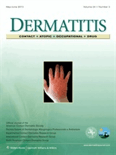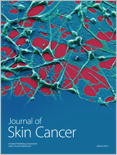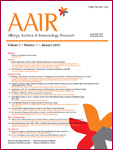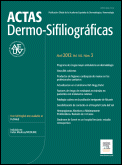
Dermatitis
Scope & Guideline
Connecting Knowledge in Dermatology and Immunology
Introduction
Aims and Scopes
- Contact Allergens and Sensitization:
The journal emphasizes research on various contact allergens, their prevalence, and the sensitization patterns observed in different populations, including occupational groups and patients with specific dermatological conditions. - Epidemiology of Dermatitis:
A core focus is on the epidemiological studies that assess the incidence and prevalence of dermatitis, particularly in relation to occupational exposures and environmental factors. - Diagnosis and Testing Methods:
The journal covers advancements in diagnostic methodologies, including patch testing techniques, the role of machine learning in diagnosis, and the evaluation of new allergens. - Treatment and Management Strategies:
Research articles often explore treatment efficacy, including pharmacological interventions, the use of novel therapies, and the psychosocial impact of dermatitis on patients. - Public Health and Preventative Measures:
The journal also highlights studies aimed at improving public health initiatives and preventive measures for dermatitis, particularly in vulnerable populations such as healthcare workers.
Trending and Emerging
- Impact of COVID-19 on Skin Health:
Research related to the effects of increased hand hygiene and use of personal protective equipment during the COVID-19 pandemic is trending, underscoring the importance of understanding skin reactions in this context. - Emerging Allergens in Cosmetics and Consumer Products:
There is a growing emphasis on identifying and studying new allergens present in cosmetics and consumer products, reflecting the increasing complexity of consumer exposure. - Psychosocial Aspects of Dermatitis:
An emerging focus on the psychosocial impacts of dermatitis, including mental health implications and quality of life assessments for affected individuals, is gaining attention in recent publications. - Workplace Dermatitis and Occupational Health:
A significant trend is the exploration of occupational dermatitis, particularly in high-risk professions, and the development of targeted interventions to reduce incidence rates. - Genetic and Molecular Research in Dermatitis:
There is an increasing trend towards genetic and molecular studies that explore individual susceptibility to contact dermatitis, enhancing the understanding of the underlying mechanisms.
Declining or Waning
- Traditional Allergen Studies:
There seems to be a waning interest in traditional studies focusing solely on well-established allergens, as newer research increasingly targets emerging allergens and complex sensitization patterns. - Generalized Dermatological Conditions:
Research on generalized dermatitis conditions, such as eczema unrelated to specific allergens, appears to be less frequent, possibly overshadowed by more focused studies on contact dermatitis. - Case Reports of Rare Allergens:
Although important, the publication frequency of case reports regarding rare allergens has decreased, as the journal shifts towards more systemic reviews and large-scale epidemiological studies.
Similar Journals

VETERINARY DERMATOLOGY
Championing excellence in veterinary dermatology since 1990.Veterinary Dermatology is a prestigious peer-reviewed journal dedicated to advancing the field of veterinary dermatology, published by Wiley. With a longstanding commitment to disseminating high-quality research since its inception in 1990, this journal has garnered significant recognition, achieving a commendable Q1 ranking in the Veterinary (miscellaneous) category for 2023 and ranking #42 out of 194 in the General Veterinary category on Scopus, placing it within the 78th percentile. Although it operates primarily on a subscription basis, the journal offers vital insights into the latest developments, clinical practices, and case studies in veterinary skin disorders. By serving as a crucial platform for researchers, veterinary professionals, and students, Veterinary Dermatology empowers its audience with the knowledge necessary to enhance animal healthcare and well-being across diverse environments. With its focus on cutting-edge research and its contribution to the global veterinary community, this journal remains an indispensable resource for those dedicated to the field.

Journal of Skin Cancer
Fostering Global Collaboration in Skin Cancer StudiesThe Journal of Skin Cancer, published by HINDAWI LTD, serves as a vital platform for advancing knowledge in the fields of Dermatology and Oncology. Established as an Open Access journal since 2011, it ensures wide dissemination of research findings, making significant contributions to the understanding of skin cancer pathogenesis, diagnosis, and treatment strategies. The journal holds a respectable rank within the academic community, reflected in its Q3 category placement in both Dermatology and Oncology for 2023, as well as its Scopus rankings, which place it in the 49th and 34th percentiles, respectively. Targeting an audience that includes researchers, healthcare professionals, and students, the Journal of Skin Cancer not only aims to present original research but also solicits reviews and case studies, thereby fostering a rich academic dialogue. With its headquarters located in London, England, the journal encourages global engagement and collaboration among scholars committed to improving outcomes in skin cancer.

Dermatologie in Beruf und Umwelt
Innovating Solutions for Dermatological Challenges in Diverse EnvironmentsDermatologie in Beruf und Umwelt is a reputable journal published by DUSTRI-VERLAG DR KARL FEISTLE, focusing on the intersection of dermatology, occupational health, and environmental influences on skin health. With its ISSN 1438-776X and E-ISSN 1616-7090, this journal serves as a crucial platform for disseminating research findings and clinical practices that address the dermatological concerns arising in diverse occupational settings. Although the journal's coverage in Scopus concluded in 2021, it remains significant within the medical community, evidenced by its rankings within the 29th percentile in Medicine - Dermatology and 20th percentile in Medicine - Public Health, Environmental and Occupational Health. While it follows a traditional access model, its commitment to enhancing knowledge and promoting best practices in skin health makes it an essential resource for researchers, clinicians, and public health professionals eager to explore the complex relationship between work environments and dermatological outcomes.

Allergy Asthma & Immunology Research
Transforming findings into clinical excellence.Allergy Asthma & Immunology Research, published by the Korean Academy of Asthma Allergy & Clinical Immunology, is a leading journal dedicated to advancing the fields of immunology, allergy, and respiratory medicine. With an ISSN of 2092-7355 and an E-ISSN of 2092-7363, this esteemed publication has been a cornerstone for researchers and practitioners since its inception in 2009 and continues to disseminate critical findings through till 2024. The journal is ranked in the Q3 category in Immunology and the Q2 category in Immunology and Allergy as well as Pulmonary and Respiratory Medicine, illustrating its impact in these vital fields. With a solid Scopus ranking in multiple sub-disciplines, the journal not only contributes to the scientific discourse but also promotes innovative research and clinical practices. Although currently operating without an open access model, the journal remains highly regarded for its thorough peer-review process and commitment to academic excellence, making it an essential resource for professionals, researchers, and students passionate about advancing knowledge in allergy, asthma, and immunology.

Actas Dermo-Sifiliograficas
Advancing Dermatological Insights for a Healthier TomorrowActas Dermo-Sifiliograficas, published by Elsevier España, stands as a pivotal resource in the realms of dermatology, histology, and pathology and forensic medicine. With its ISSN of 0001-7310 and E-ISSN 1578-2190, this esteemed journal has transitioned to an Open Access model since 2020, facilitating broader dissemination of impactful research. Operating from its Madrid headquarters, it has been a vital platform for scholarly exchange since its inception in 1945, continuing through its converged years until 2024. The journal holds a Q3 ranking in dermatology, histology, and pathology and forensic medicine as of 2023, reflecting its relevance in the academic community where it ranks 79th in dermatology and 126th in pathology among its peers. With a commitment to advancing knowledge and practice in its fields, Actas Dermo-Sifiliograficas serves as an essential repository for researchers, professionals, and students seeking to engage with the latest findings and innovative perspectives in skin and disease research.

Turkderm-Turkish Archives of Dermatology and Venerology
Championing Global Access to Dermatology DiscoveriesTurkderm - Turkish Archives of Dermatology and Venerology, published by GALENOS PUBL HOUSE, serves as a vital platform for the dissemination of innovative research and advancements in the fields of dermatology and venerology. With an Open Access policy implemented since 2002, this journal aims to provide free and unrestricted access to significant findings, ensuring that vital information reaches a global audience. Based in Turkey, the journal has positioned itself as an important resource for professionals, researchers, and students alike, despite currently being categorized in Q4 of both Dermatology and Infectious Diseases as per the 2023 metrics. Although it faces competition in the rankings, with a Scopus standing of #131 in Dermatology and #331 in Infectious Diseases, its dedication to advancing knowledge in these critical health areas is unwavering. The journal continually invites original research, reviews, and case studies that enhance clinical practices and foster understanding in the dermatological community.

JOURNAL DER DEUTSCHEN DERMATOLOGISCHEN GESELLSCHAFT
Elevating the standard of dermatological research and practice.JOURNAL DER DEUTSCHEN DERMATOLOGISCHEN GESELLSCHAFT, published by Wiley, is a prominent periodical in the field of dermatology, recognized by its Q2 quartile ranking in the 2023 dermatology category. With a dedicated focus on advancing knowledge in dermatological science, the journal publishes rigorous peer-reviewed research that encompasses a range of topics including clinical studies, research methodologies, and innovative treatment practices in dermatology. Its impact is reflected in its Scopus ranking, where it stands at #48 out of 142 in the medicine dermatology category, placing it in the top 66th percentile. Although not an Open Access journal, it serves as a critical resource for researchers, clinicians, and students alike, facilitating the dissemination of high-quality research findings and fostering a deeper understanding of dermatological conditions and treatments. With years of convergence from 2003 to 2024, this journal remains a vital platform for scholarly dialogue and discovery in dermatology.

Dermatology Reports
Exploring the frontiers of skin health and healing.Dermatology Reports is a reputable open-access journal dedicated to advancing the field of dermatology through innovative research and clinical studies. Published by PAGEPRESS PUBL, this journal has been providing unrestricted access to valuable scientific content since 2009, promoting the dissemination of cutting-edge knowledge among researchers, professionals, and students alike. With an ISSN of 2036-7392 and an E-ISSN of 2036-7406, Dermatology Reports is indexed in Scopus, currently holding a rank of 93/142 in the Medicine - Dermatology category, placing it in the 34th percentile. The journal, based in Italy at MEDITGROUP, VIA G BELLI, 4, PAVIA 27100, aims to foster a multidisciplinary approach to dermatological research and practice, with a vision to converge various aspects of the field from 2010 to 2024 and beyond. With its Q3 quartile ranking in 2023, Dermatology Reports stands as a critical platform for highlighting novel findings and therapeutic strategies that shape the future of dermatological science.

ANNALES DE DERMATOLOGIE ET DE VENEREOLOGIE
Elevating Standards in Skin Health ResearchANNALES DE DERMATOLOGIE ET DE VENEREOLOGIE is a distinguished journal that serves as a vital platform for disseminating innovative research and insightful reviews in the field of dermatology and venereology. Published by MASSON EDITEUR, this journal has been a cornerstone for professionals and researchers since its inception in 1977, offering a wealth of knowledge that spans decades. With its ISSN 0151-9638 and E-ISSN 2214-5451, it is indexed within leading databases, ensuring that the published work reaches a broad audience. The journal currently holds a Q3 ranking in the dermatology category, reflecting its commitment to quality and rigorous peer-review processes. While the journal is not open access, it provides an extensive archive of valuable studies that contribute to advancements in skin health and treatment methodologies. Located in Issy-les-Moulineaux, France, ANNALES DE DERMATOLOGIE ET DE VENEREOLOGIE continues to attract submissions from esteemed professionals, enhancing its reputation as a crucial resource for those dedicated to the ongoing development of dermatological sciences.

Asia Pacific Allergy
Advancing Allergy Insights Across the Asia PacificAsia Pacific Allergy, published by Lippincott Williams & Wilkins, is a prominent academic journal dedicated to advancing research and clinical practice in the fields of dermatology, immunology, and allergy. With its ISSN 2233-8276 and E-ISSN 2233-8268, the journal provides a platform for innovative studies and reviews that cater to an international audience of researchers, healthcare professionals, and students involved in allergy and related disorders. Although it does not currently offer open access to its publications, the journal's robust output from 2015 to 2017 and its ongoing contribution to the literature from 2021 to 2024 showcase the evolving landscape of allergy research in the Asia Pacific region. Recognized in the 2023 Journal Citation Reports, it holds a Q2 ranking in Dermatology and a Q3 ranking in Immunology and Allergy, while its Scopus ranks further emphasize its significance within these domains, positioning it among the top journals in the field. As a source of cutting-edge research, Asia Pacific Allergy plays a vital role in fostering collaboration and knowledge dissemination, ultimately assisting in the betterment of patient care and treatment strategies across the region.